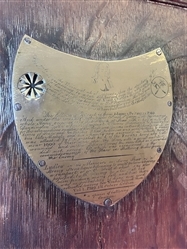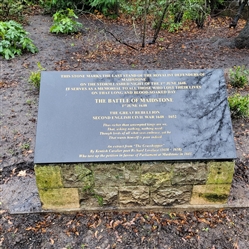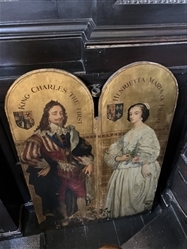Fenwick, Sir John d.1644
Title:
Knight
Military Rank:
Colonel
First Name:
John
Last Name:
John
Memorial Type:
Memorial - Other
Does the monument still exist?
Yes
Installation Date:
Helmet in Hexham Abbey c.1823, skull since 1915. Since 1989 both transferred and displayed in Hexham Old Gaol Museum
Inscription:
1977: Exhibited in a glass case in the North Chancel Aisle “Museum” as item No.50: “Skull of John Fenwick whose Salade hangs in the Nave. A Colonel in the Dragoon Guards, killed at Marston Moor 1644”.
Allegiance:
Royalist
Condition:
Good
Condition Description:
Photographic evidence
Memorial Notes:
Italian sallet, c.1460, believed to have been worn by the Duke of Somerset at the Battle of Hexham in 1464. He was captured at the battle, and beheaded in Hexham Marketplace. Tradition has it that it was later worn by Colonel John Fenwick who was killed at the Battle of Marston Moor, 2 July 1644. From the collection of Hexham Abbey [HEXAB2198; HEXAB9019.49: HEXAB2124: HEXAB9517 ]
Associated skull allegedly of Sir John Fenwick showing, like the helmet, matching evidence of a severe blow to the head with a heavy sharp implement such as an axe. The direction of the wound would suggest he was hit from behind. Cause of Death: The parietal damage with resultant hæmorrhage would have been sufficient to cause death. Absence of bony healing around this would suggest no significant interval between its infliction and death.
(Dept of Oral Pathology, University of Newcastle Upon Tyne, 1992)
“The helmet is that of Fenwick, who was slain at the Battle of Marsden Moor. His skull, which was broken in the same place with the helmet, is still kept at the Manor Office. Concerning this skull, its power of motion, and its love for one particular room, to which it would always return when removed, many stories, as surprising as they are true, long delighted and terrified the servants of the Abbey and their gossips. Now, however, the legends are lost or disregarded, and the skull lies very quietly in its appointed place.” [A B Wright's History of Hexham, 1823 fn.5 pp90–91]
1915: “We appreciate Viscount Allendale's kindly thought and interest in presenting to the Abbey as one of its relics the reputed skull of Sir John Fenwick, who was slain at the Battle of Marston Moor in 1644, while fighting on the King's side.” [Hexham Parish Mag. Sep 1915]
1977: Exhibited in a glass case in the North Chancel Aisle “Museum” as item No.50: “Skull of John Fenwick whose Salade hangs in the Nave. A Colonel in the Dragoon Guards, killed at Marston Moor 1644”.
1988: “Museum Committee. It was felt that the skull and helmet [HEXAB2198] should be offered to the Border Museum, it being a more suitable place for the display of these objects.” [Abbey Chronicle, Nov. 1988. PCC News, p.2]
1989: “Agreement between the Rector, Hexham Abbey and Tynedale District Council relating to the loan of the Skull and Helmet of Sir John Fenwick.” [Signed & Sealed 7 Mar. 1989] Transferred to the Border History Museum in the Manor Office, known since 1992 as the Old Gaol.
1990: “A row broke out over the future of the skull of Sir John Fenwick, a cavalier from Hexham, killed fighting for King Charles at the Battle of Marston Moor in the Civil War. The skull was on display in the town's Border History Museum, but some councillors felt that it was in poor taste, and should be given a decent burial.” [Hex. Cour. 24.3.2000 – 10 Years Ago]
“A move to provide a decent burial for the remains of Sir John Fenwick, a Hexham cavalier killed at the Battle of Marston Moor, whose skull had long been on display as an item of curiosity in the Border History Museum in Hexham, was defeated as the grisly relic was regarded as an important piece of Hexham's history.” [Hex. Cour. 20.3.2015 – 25 Years Ago]
Hexham Old Gaol Museum
EP 184/140 (1964) Papers re the Fenwick Sallet.
Faculty: 2015. 7 May. The extension of the loan of the skull and helmet of Sir John Fenwick to the Woodhorn Trust for five years.
Faculty no.6517: 2015. 14 May. The extension of the loan of the skull and helmet of Sir John Fenwick to the Woodhorn Trust for five years.
https://museumsnorthumberland.org.uk/our-collections/arms-and-armour/
John Fenwick mustered a troop of horse for the Second Bishops' War of 1640:
Aug. 5.
Hexham.
42. Certificate by the captain and officers of John Fenwick's troop of horse to the same. The troop consists of the same number now as last time, and agrees in all with the muster roll delivered to his Lordship on July 20, 1640, viz., 10 officers, 60 horsemen, and four waggon horses. (CSPD)
Memorial Address:
Hexham Old Gaol Museum, Hallgate, Hexham NE46 1XD
County:
Northumbria
Country:
England
Geoloation:
54.97183311884823, -2.10032790740649





